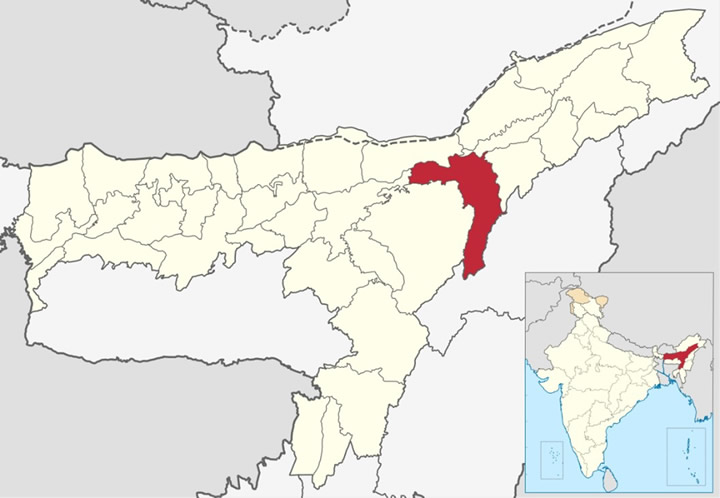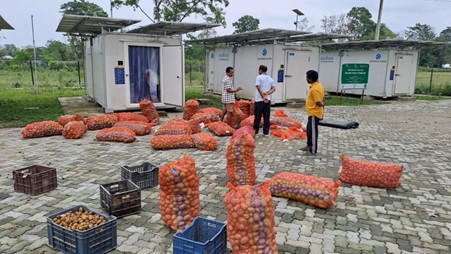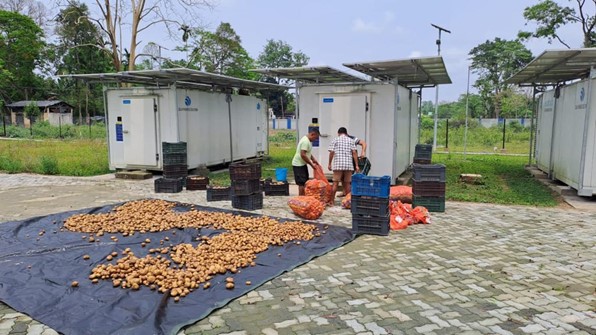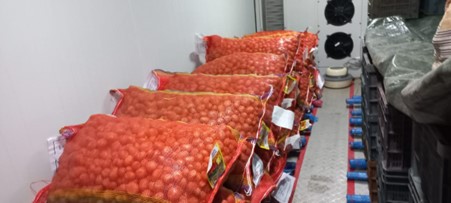The local farmers were informed about the Solar-Powered Cold Storage through the field staff and the District Agriculture Department. About 40 farmers started using Solar Cold Storage facilities in a year, primarily for storing potatoes.
 Improving Post Harvest Management through Portable Solar Cold Storage Systems – A Case Study from the Northeastern Part of India
Improving Post Harvest Management through Portable Solar Cold Storage Systems – A Case Study from the Northeastern Part of India

Mr Ramchandra Pal, Senior Field Manager & Dr. Manjushree Banerjee, Independent Researcher | The Energy and Resources Institute, New Delhi, India.
Assam is a state situated in the Northeastern part of India. In this state, Bokakhat is a town situated in the Golaghat district. The district has eight development blocks. One of the administrative blocks is Bokakhat. The majority of farmers in this block grow paddy, horticultural crops (mostly tomato, and pumpkin), and potatoes. Generally, the farmers sell the perishable crops (like pumpkin, tomato, and potato) in the market within a speculated time after harvest. Many times, due to the huge-colossal supply of perishable produce in the market at the time of harvest, the prices fetched are below the level of the farmer’s expectation. The nearest cold storage from the Bokakhat block is in another district Jorhat which is at a distance of about 70 km.

Figure 1 Location of Golaghat District in India
The district administration indicated the need for innovative value-added post-harvest management for better sale prices and value of agricultural produce. The Numaligarh Refinery Limited (NRL) is situated in the district Golaghat and takes up several rural developmental works under its Corporate Social Responsibility. NRL in association with the knowledge partner The Energy and Resources Institute (TERI) implemented the concept of installation of Solar Powered Cold Storage for the benefit of local farmers.
A scoping study was conducted along with a thorough study of local weather conditions for a year. The specifications were developed based on the scoping study, solar radiation, and weather conditions. The insulated Cold Storage room has PPGI (Pre-Painted Galvanized Iron Steel) lined sheets on the outside and PUF (Polyurethane foam) panels of minimum 100 mm thickness inside. A Temperature and Humidity Monitor is located near the Cold Storage door. It displays the temperature and humidity of the cold room. This is an innovative solar cold storage device with the facility for real-time data monitoring and predictive maintenance through a mobile-based app using Bluetooth or the Internet. Per minute logging GPRS (General Packet Radio Service) is visible on the screen of a computer or smartphone. The solar-powered cold storage functions with the technique that the cold room uses thermal energy storage to provide back-up during non-sunshine hours through metal plates, with both forced convection and radiant cooling and it maintains the temperatures from 4°C to 10°C for up to 30 hours with a required humidity. The structure of the storage room has been designed in such a way as to make cleaning, loading, and unloading easy for the users.
Four units of Solar Powered Cold Storage were set up in September 2022 as part of the pilot project to understand the feasibility of the technology at the local level. These units were set up in the Bokakhat town and one dedicated field staff took care of the administrative and overall maintenance work.
The local farmers were informed about the Solar-Powered Cold Storage through the field staff and the District Agriculture Department. About 40 farmers started using Solar Cold Storage facilities in a year, primarily for storing potatoes. These farmers initially used a cold storage facility at Jorhat for potato storage. A farmer, who kept his potatoes for two months in the Solar Cold Storage expressed his satisfaction with the service. This farmer, about a year later, formed an informal group of about 12 farmers to store their potatoes in Solar Cold Storage. Pumpkins and tomatoes were also stored. However, the most preferred produce to store in the cold storage remains the Potatoes. The farmers use these potatoes as seeds.

Photo 2 Seed Potatoes Ready for Cold Storage

Photo 3 Loading of Seed Potatoes Inside Solar Powered Cold Storage

Photo 4 Seed Potatoes Inside Solar Powered Cold Storage
The yearlong pilot provided many learnings too. During continuous cloudy days, the power supply in solar cold storage was not adequate. Therefore, the grid was connected with the Solar Cold Storage to overcome. Now, Solar Cold Storage operates in a hybrid mode. The grid electricity is a backup source for the cloudy days.
Detailed training for operation and maintenance for about the basics of the technology of Solar Cold Storage, post-harvest management, day-to-day operations, and maintenance was provided by the Supplier to farmers and operators of the solar cold storage units at the time of installation. However, as the concept was new in the area, the training was repeated, particularly on the aspects of temperature and humidity settings. The repeat trainings were found beneficial as the staff now had first-hand experience.
The most important aspect during the pilot phase remained repair and maintenance. The supplier of the technology and TERI monitored the functionality of all the Cold Storage Units through a Remote Monitoring Mechanism. During the warranty period, the suppliers addressed the fault reports promptly. In addition, the staff was able to monitor the functionality of the Cold Storage 24X7 through the mobile screen. The Annual Maintenance Contract is for three years. A regular monitoring and repair service is a necessity for optimal functionality of the Cold Storage Units.
The Cold Storage Units in the Bokakhat Town have reduced the distress sale of perishable produce. This further helped in the overall increase in income of the farmers from agriculture. In addition, the farmers are saving their transportation costs as a Cold Storage facility is available nearby of their agriculture fields.
The technology of Solar Cold Storage in hybrid mode worked well in the area. The farmers expressed their interest in installing one or two units of Solar Cold Storage in various locations to reduce the transportation drudgery further. Solar Cold Storage has significance in the area due to the lack of any other cold storage unit in the vicinity, and increased income of the farmers. There is scope for replication of the technology.
The pilot project indicates the suitability of the Solar Cold Storage Units in smaller administrative units. However, there is always a need for adequate repair and maintenance services along with a power backup arrangement. Solar cold storage systems have offered a sustainable solution for preventing perishable goods by leveraging renewable energy sources to provide reliable cooling. Cold Storage enables farmers to store their produce until market conditions are favorable to fetch expected prices for their produce. The farmers can wait for demand to increase or prices to rise before selling their goods. This flexibility allows farmers to negotiate better on prices and avoid selling their produce at lower prices during periods of oversupply. Solar-powered cold storage helps in minimizing the post-harvest losses by providing a reliable solution for preserving produce at optimal temperatures.
The content & opinions in this article are the author’s and do not necessarily represent the views of AgriTechTomorrow
Comments (0)
This post does not have any comments. Be the first to leave a comment below.
Featured Product

